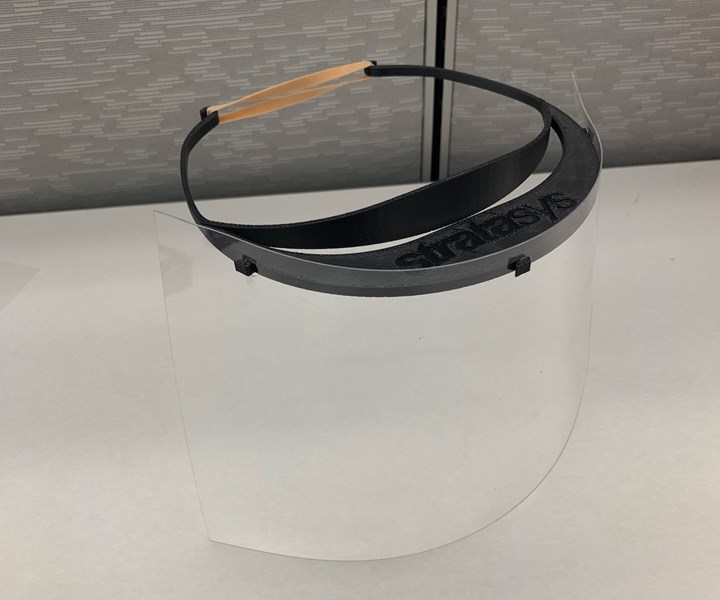Stratasys Producing 3D-Printed Face Shields In Response to Coronavirus Pandemic
Any 3D printing shop in the U.S. that wishes to help print plastic frames, can fill out an online form to be invited to join the effort.
Stratasys has announced a global mobilization of the company’s 3D printing resources and expertise to respond to the COVID-19 pandemic. The initial focus is on providing thousands of disposable face shields for use by medical personnel.
In the U.S, Stratasys has set an initial goal of producing 5,000 face shields by Friday, March 27, at no cost to the recipients. This includes both a 3D-printed frame and a clear plastic shield that covers the entire face. The company will have the ability to scale to an even faster rate of production.
Any 3D printing shop in the U.S. that wishes to help print plastic frames, can fill out an online form to be invited to join the effort. The company is also posting the full face shield printing and assembly instructions on Monday, Mar. 23 on its COVID-19 response page.
One of the world’s top hospitals has told Stratasys they use 1,530 disposable face shields every week even without the surge created by COVID-19 and is down to six days’ inventory on hand, with the pandemic still building momentum.
Stratasys said medical technology leader Medtronic and Minneapolis-based Dunwoody College of Technology will provide support for the plastic shield material.
Stratasys has scores of professional 3D printers available to apply to the challenge of producing shields at scale, particularly across its Stratasys Direct Manufacturing facilities, which are based in Eden Prairie, Minn., in and around Austin, Texas, and Valencia, Calif. A number of other large manufacturers and educational institutions with production grade 3D printers have donated their capacity to help. These include Wentworth Institute of Technology in Boston, Queensborough Community College in New York City, and the Savannah College of Art and Design in Savannah, Ga.
Stratasys has set up a web page where organizations can request 3D printed products to help with the crisis, offer 3D printing capacity, or request 3D printers or material for medical- or safety-related purposes.
The company is also planning to respond to the crisis in additional ways. An initiative led by anesthesiology residents of Massachusetts General Hospital called the CoVent-19 Challenge is planning to ask engineers and designers to help develop a new rapidly deployable ventilator and other innovative solutions to the ventilator shortage, and Stratasys plans to support the challenge and promote it via its GrabCAD community of more than 7 million professional designers, engineers, manufacturers and students.
“We are humbled by the opportunity to help. We see additive manufacturing as an essential part of the response to the COVID-19 global epidemic,” said Stratasys CEO Yoav Zeif. “The strengths of 3D printing – be anywhere, print virtually anything, adapt on the fly – make it a capability for helping address shortages of parts related to shields, masks, and ventilators, among other things. Our workforce and partners are prepared to work around the clock to meet the need for 3D printers, materials, including biocompatible materials, and 3D-printed parts.”

Stratasys and its partners are producing several thousand face shields with 3D-printed plastic frames.

Related Content
-
Freeform Injection Molding Eases the Path to Medical Device Product Testing
A development and manufacturing service provider is using dissolvable molds to build injection molded silicone prototypes.
-
Getting into Plastics Additive Manufacturing? Avoid these Six Common Errors
There are a lot of 3D printing technologies out there, and it’s not uncommon for processors new to additive manufacturing to get tripped up. Here are some typical snafus, along with advice on how to avoid them before you start making parts.
-
Daimler, OMIC Evaluate Wire-Fed DED for Moldmaking
3D printing a core and cavity on machine from Gefertec, followed by machining, allowed for a complete mold tool to be produced in three days.
















